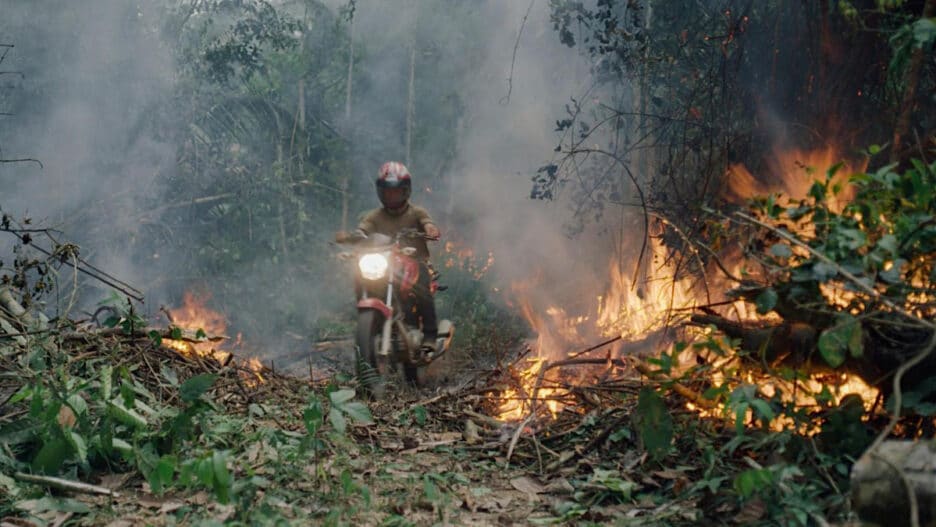By the end of 2021, the Brazilian Amazon rainforest experienced its highest rate of deforestation in 15 years. Recent data suggests that there are signs of a loss of resilience in more than 75% of the forest. If nothing is done to stop it, it’s expected that the ecosystem of the Amazon could collapse within the next 50 years. This crisis affects the whole world, but it especially harms indigenous communities in the area, who not only face the potential destruction of their home, but also the erasure of their way of living. This is the backdrop of National Geographic and Picturehouse’s latest documentary The Territory which premiered at Sundance earlier this year and, after winning multiple awards, is now playing in select theaters. Directed by Alex Pritz, this must-watch film provides an insightful exploration of the complexities of deforestation with a special emphasis on the human stories behind each of the frontlines.
Unlike plenty of the media that already explores deforestation academically and in the abstract, The Territory gives a face and a voice to people living in the Amazon who are waging a war for the future of the rainforest. The film focuses on the Uru-eu-wau-wau people, who, despite decreasing numbers, relentlessly protect the vast expanse of rainforest that they call home, which is constantly encroached by far farmer’s associations and individual land grabbers aiming to seize control.
Audiences are given an inside look at the daily life of the Uru-eu-wau-wau, from their traditions to their internal discussions. All of this is anchored on the story of Bitaté, a young indigenous man who was recently selected as the president of the Jupaú Association, an organism that connects the community with outside entities. He has to direct the community’s response to the increasing number of invasions and is supported by Neidinha Bandiera, an environmental activist. Their struggles amidst increasing violence and an ever-less-sympathetic government are evidence of their resilience but also a clear depiction of the complex efforts that these communities have to endure to protect their homes.
The Territory stands out due to the filmmakers refusing to give a one-sided account of the crisis. The film engages with the perspectives of those wanting to occupy the Uru-eu-wau-wau territory and are given just as much screen time to explain their rationales and their experiences. However, the film achieves a sense of balance without framing the issue under a false equivalency. The power differentials are clear, and the existential nature of the conflict for the Uru-eu-wau-wau is never downplayed. For them, it’s not about economics, but about survival.
The perspectives of the settlers echo ideas of Manifest Destiny and traditional narratives of the American West. The film incorporates this with cinematography that features the expansive environmental shots that are common in Westerns. Instead of traditional deserts, the images portray the immensity of the jungle or the heart-wrenching devastation of fires. These visuals are married with a close and intimate portrayal of the daily life of both the Uru-eu-wau-wau and the settlers. In fact, some of the footage was taken by the Uru-eu-wau-wau themselves. This keeps the focus grounded on a specific community, while also conveying at all times that the implications of the overall conflict are much much larger, and with an urgency that is further conveyed by Katya Mihailova’s intense score.
The Uru-eu-wau-wau use technology such as radars, drones, and cameras to accurately document the invasions of their territory, which has helped to make outsiders take their claims seriously. However, it also allows for their footage to be used in the film and for their perspectives to be taken into account behind the camera. This sense of collaboration further differentiates the film. It’s not only about the Uru-eu-wau-wau but also made with them. So, the footage of their daily activities, meetings, and traditions feels uniquely authentic and allows the film to further portray the multidimensional issues affecting these communities as the impact of the COVID pandemic and the increasing hostility towards them in Brazil’s political discourse.
The documentary is always engaging, and its hyper-local approach is distinctive and effective. Still, it could have benefitted from exploring some of the larger interests at play. While the threat of the Bolsonaro administration is mentioned, there is not a clear focus on policy choices or on the companies participating in the deforestation process. The local perspective is a fascinating one, but it requires familiarity with the issue and might leave audiences that are unfamiliar confused.
Despite the efforts of the Uru-eu-wau-wau, deforestation continues. Indigenous communities are still affected and the conflict for the future of the lungs of the world keeps raging in the Amazon. Yet, The Territory tackles this issue with humanity and complexity and shows us that, much like Uru-eu-wau-wau, we need to continue diligently trying to protect the planet.
Advertisement
The Territory is out now in limited release. Watch the trailer below.
Advertisement
